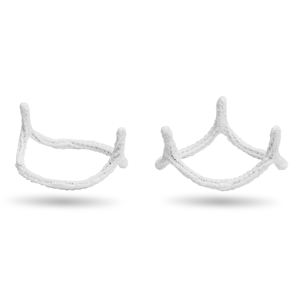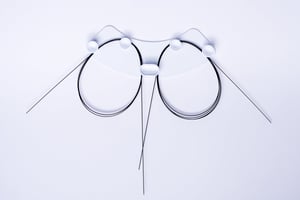Memo 4D™
CORCYM has developed a semi-rigid annuloplasty ring that reshapes mitral repair: The Memo 4D™ turns artificial chordae replacement into standard procedure, thanks to its innovative ReChord system.
- unique range of sizes with up to 42 mm to treat large annuli
- progressive increase of anteroposterior diameter to accommodate excess leaflet tissue and reduce risk of systolic anterior motion (SAM)
- exclusive gradual saddle shaping (size 34-42) to restore physiological geometry in enlarged annuli that have lost their 3D profile
- balance of rigidity and flexibility to cover a comprehensive range of mitral valve repair needs
- three-layer design: oval silicone sheath, nitinol cell structure, Carbofilm™ coating
- 3D motion of mitral annulus to maximize blood flow even 5 years post implantation
Memo 4D™ relies on a chordal guiding system that aims to standardize neochordae implantation without physical measurement.
A series of loops in the posterior region serve as temporary reference elements for easier length sizing of chords (both for anterior and posterior repair).
The ReChord system promotes standardized chord implantation, offering a reproducible technique while accelerating procedure times.
Clinical study 2018
“The Memo 3D ring maintained a physiological saddle-shape configuration throughout the cardiac cycle. Real-time three-dimensional echocardiography analysis confirmed the motion and flexibility of the Memo 3D ring upon implantation.”
Nishi et al. Gen Thorac Cardiovasc Surg 2018. DOI: 10.1007/s11748-018-0886-1
Clinical study 2018
“This new annuloplasty ring facilitated determination of appropriate neochord length and was used to successfully treat different degenerative pathologies affecting both leaflets. This new device simplified length determination of the neochords.”
Prinzing et al. Ann Thorac Surg 2018. DOI: 10.1016/j.athoracsur.2017.12.030
Clinical study 2015
“This is a simple and reproducible technique, suitable for both anterior and posterior leaflet prolapse, which restores leaflet motion and ensures a large surface of coaptation. According to our experience, the temporary chordal guide system allows a correct implantation of PTFE [polytetrafluoroethylene] neochordae without the need for chordal measurement, short operative times and doesn't require a long learning process. In our opinion, its use might standardize the ‘respect rather than resect’ mitral valve repair technique, further facilitating a MIMV [minimally invasive mitral valve] surgical approach.”
Glauber et al. Ann Cardiothorac Surg 2015. DOI: 10.3978/j.issn.2225-319X.2015.04.0






